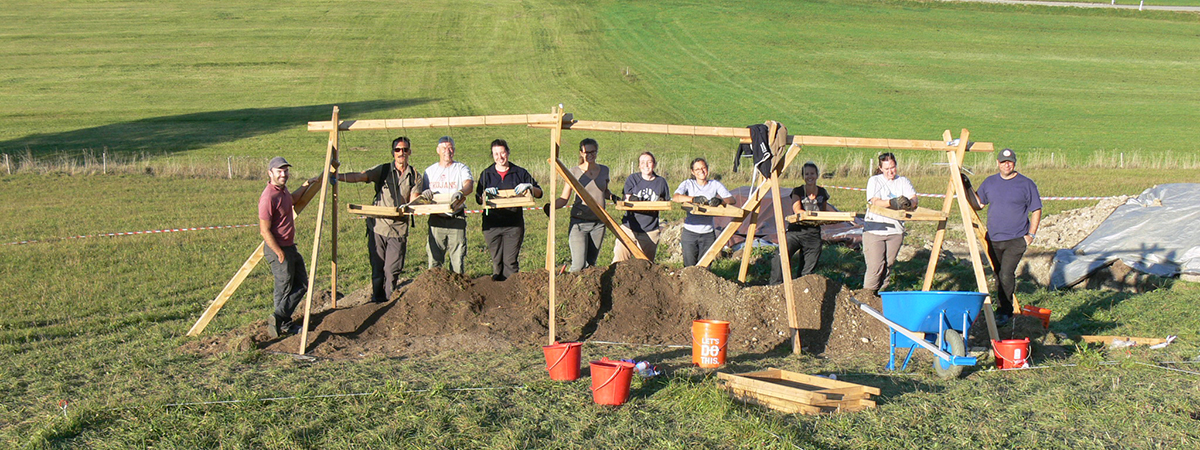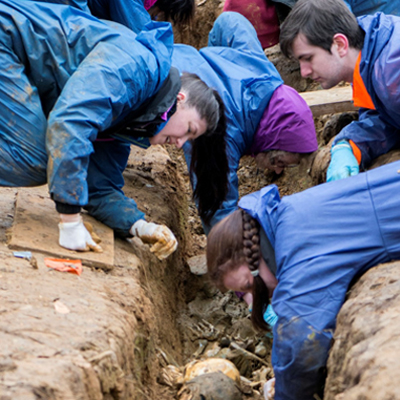
A team of archaeologists and forensic specialists from Cranfield Forensic Institute (CFI) has assisted with the recovery and identification of U.S. Army Air Forces Staff Sgt. Edgar L. Mills who was killed in action over Germany during the Second World War.
Members of the Cranfield Recovery and Identification of Conflict Casualties (CRICC) team deployed to the crash site at Kimratshofen, Germany, in 2018 as part of their first collaboration with the U.S. Defense Prisoner of War/Missing in Action Accounting Agency (DPAA) .
There are thought to be around 72,000 American personnel still unaccounted for from WW2 alone, with around 39,000 deemed to be recoverable. The DPAA has been partnering with Cranfield University as part of its efforts to forge new relationships with experts and enhance its recovery efforts in Europe.
Dr Nicholas Márquez-Grant, Senior Lecturer in Forensic Anthropology, said: “It is a great honour to be involved in the search for missing servicemen and assist with the recovery and dignified burial of human remains; bringing closure to families when possible. Once our work in the field is complete, the overall identification process by DPAA scientists is thorough and can take some time. We’re so pleased to hear that we contributed to accounting for Staff Sgt. Mills.”
Archaeological recovery and identification of the missing
A team of approximately 15 staff and Forensic Archaeology and Anthropology MSc graduates were tasked with searching areas around the impact crater resulting from the aircrash of a bomber B-17G and found possible human remains during the excavation. The work involved sifting through tonnes of soil to find fragments of human remains or personal items which could help to identify a number of missing crew members.
Evidence found during the excavation was documented and then sent to the US as part of the DPAA recovery protocol. Scientists from the DPAA and US Armed Forces Medical Examiner System then used dental, anthropological, and mitochondrial DNA (mtDNA), analysis to identify Mills’ remains.
Roland Wessling, Lecturer in Forensic Archaeology & Anthropology, said: “Sometimes we don’t find anything on excavations such as this, and sometimes we don’t know what we have found. One small fragment of bone can be enough to identify somebody.
“It also depends on how the land has been used since the incident occurred – where fields have been ploughed or there has been human activity, we often find only small fragments. In boggy or forested areas, it is common to find larger plane parts such as propellors, machine guns and ammunition. The discovery of oxygen masks, goggles, and pieces of seatbelt can also be an indicator of being close to finding human remains.”
Shot down during a bombing raid
In the summer of 1944, Staff Sgt. Mills, 25, was an armorer gunner onboard a B-17G which was shot down during a bombing raid on enemy aircraft and air defence installations around Memmingen, Germany. His body was not recovered, and the Germans never reported him as a prisoner of war.
Due to the damage to the B-17G the pilot ordered the crew to bail out. Six of the airmen parachuted successfully while the other five crew members including Mills were believed to still be on board. The surviving crew witnessed the aircraft explode and after searches of the site, Mills was declared non-recoverable in 1951.
Graduates use forensic and archaeological methods for recovery
The project team from Cranfield University consisted mostly of graduates of the Forensic MSc programme at CFI. They are experienced in employing forensic and archaeological methods to carry out recovery operations and have conducted excavations across Europe as well as further afield in the South Pacific.
Cranfield Forensic Institute graduate, Charlotte Loy, now commercial archaeologist and preparing for her next CRICC mission commented, “’Excavation at Kimratshofen was my first forensic recovery mission and I am grateful to have done it with such a talented and supportive team. Hearing that Sergeant Mills was identified, and our work at Kimratshofen led to his family finally getting answers, is the most rewarding outcome we could hope for. I am grateful to have worked with such a talented and supportive team and know that groups like ours continue to make sure the loss of so many lives are not forgotten, so long as we can remember and build on what is there.”
Partners contribute to increasing success of field missions
DPAA is an agency of the US Department of Defense and was formed from the merger of several smaller agencies in 2015. Its mission is to locate, identify, and repatriate the remains of American personnel from past conflicts (including WW2, the Korean War, the Vietnam War, the Cold War and the Iraq and Persian Gulf Wars) who are unaccounted for.
The DPAA commented: "The Defense POW/MIA Accounting Agency appreciates the contributions by our partners in assisting DPAA with its mission to account for missing military personnel lost in covered past conflicts. Partners like Cranfield University bring experience and resources that can expand the Agency’s capacities and capabilities.
“Partners have demonstrated a deep and long-standing commitment to the accounting mission, and their support has resulted in an increasing number of successful field missions. Partners are also providing valuable and creative support for the Agency’s historical research activities and other efforts, to include the Agency’s innovation programs and projects."
Staff Sgt. Mills was buried at Arlington National Cemetery on 4 th May 2023.



